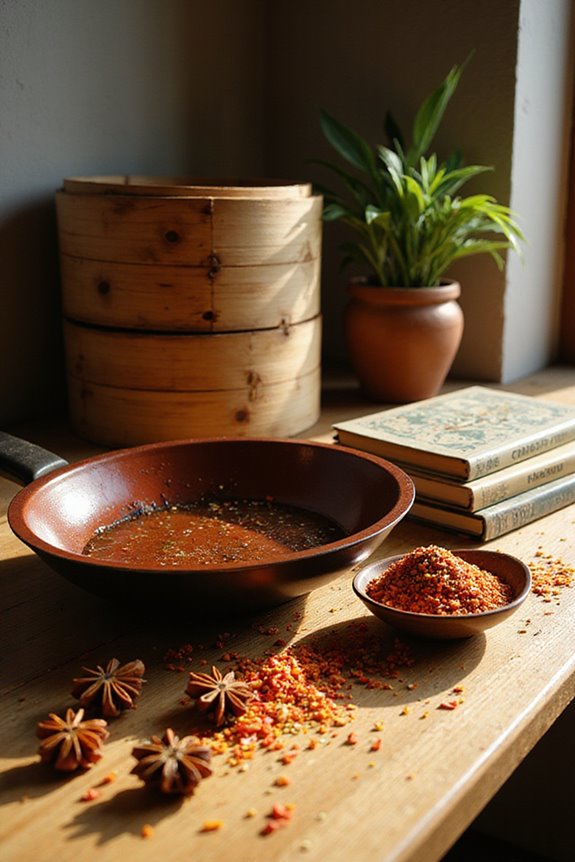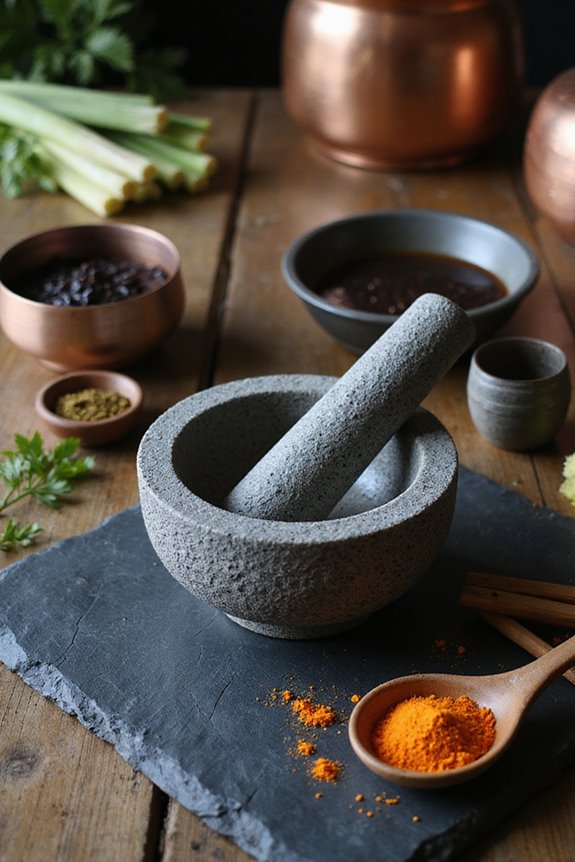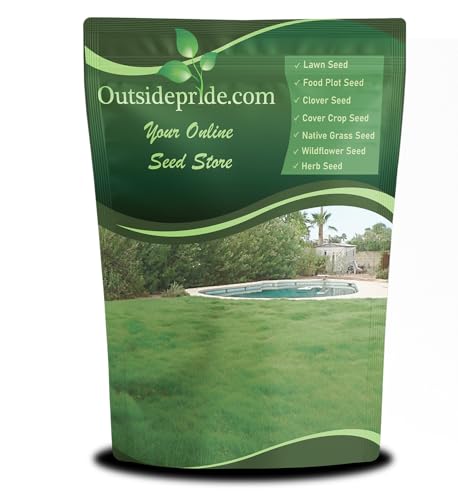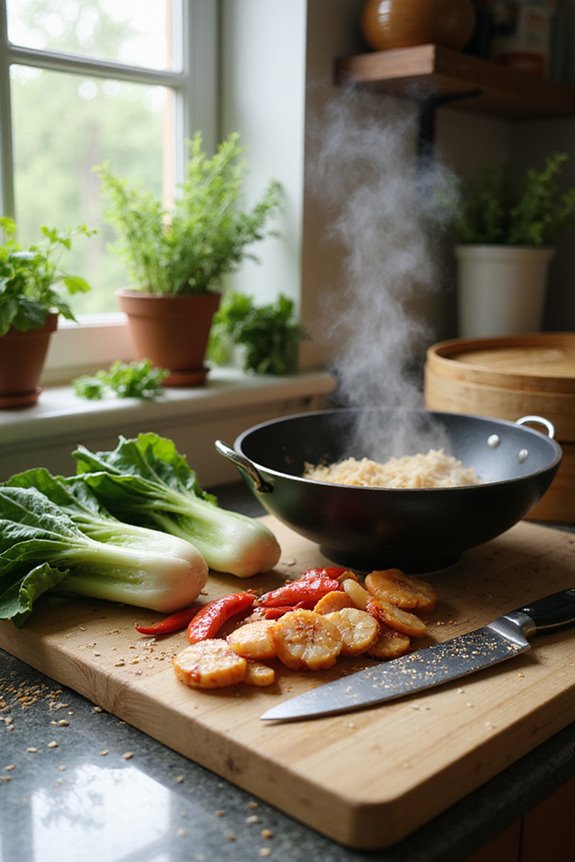As an Amazon Associate, we earn from qualifying purchases. Some links may be affiliate links at no extra cost to you. Although our opinions are based on curated research, we haven't used these products. Articles generated with AI.

5 Best Drought-Tolerant Landscape Plants to Transform Your Garden This Year
Transform your garden with these five top drought-tolerant plants: Arizona’s native desert marigold, resilient blue grama grass, tough Texas sage, vibrant agave, and low-maintenance red yucca. These selections thrive in arid conditions, requiring less water and maintenance. They support local wildlife and enhance your landscape’s beauty. Consider native options for optimum performance; their deep roots improve soil quality while needing little attention. If you want to explore more options and techniques, there’s plenty more to discover ahead.
Key Takeaways
- Agave: This striking succulent requires minimal water and thrives in poor soil, making it perfect for arid landscapes and low-maintenance gardens.
- Lavender: Known for its aromatic flowers, lavender is drought-resistant and attracts pollinators, offering beauty and utility to your garden.
- Russian Sage: This resilient perennial features silvery foliage and purple flowers, thriving in dry conditions while adding visual interest to any landscape.
- Sedum: With various species available, sedums are low-growing, drought-tolerant succulents that provide vibrant color and texture with very little care.
- Yarrow: Versatile and hardy, yarrow produces striking blooms and thrives in dry soil, making it an excellent choice for sustainable landscaping.
Native Plants of Arizona
Native Plants of Arizona
- Tillman, Wes (Author)
- English (Publication Language)
- 132 Pages - 12/17/2024 (Publication Date) - Independently published (Publisher)
If you’re looking to create a beautiful garden that thrives in Arizona’s challenging climate, native plants are your best bet. “Native Plants of Arizona: A Desert Dweller’s Guide” by Wes Tillman is the perfect reference. This guide helps you understand various species, offering practical tips for sustainable landscaping in arid conditions. It features stunning visuals of trees, shrubs, succulents, and wildflowers, making identification a breeze. Plus, you’ll find valuable information about conservation and ecological restoration, so you can create a diverse ecosystem. With these insights, you can craft a low-maintenance, drought-tolerant landscape that not only looks great but supports local wildlife too.
Best For: Gardeners in Arizona seeking to create sustainable, low-maintenance gardens using native plants adapted to arid climates.
Pros:
- User-friendly reference with concise descriptions and clear visuals for easy identification of native plants.
- Practical tips and strategies for sustainable landscaping and water-wise gardening techniques.
- Emphasis on ecological restoration and biodiversity, supporting local wildlife while enhancing garden spaces.
Cons:
- May not cover all native plant species in detail, limiting some users’ diverse gardening options.
- Focuses primarily on Arizona; not ideal for gardeners outside the region or with different climates.
- Some readers may find the content more suitable for beginners, potentially lacking depth for experienced gardeners seeking advanced techniques.
Drought-Resistant Planting: Lessons from Beth Chattos Gravel Garden
Sale
Drought-Resistant Planting: Lessons from Beth Chatto's Gravel Garden
- Chatto, Beth (Author)
- English (Publication Language)
- 192 Pages - 07/01/2016 (Publication Date) - Frances Lincoln (Publisher)
For gardeners looking to create beautiful, sustainable spaces amidst increasing climate challenges, Beth Chatto’s Gravel Garden offers invaluable lessons in drought-resistant planting. Her methods emphasize choosing the right plants to thrive in dry conditions, which can enhance your garden’s beauty without consuming excessive water. You’ll find practical strategies in her work, focusing on plant selection that withstands drought while offering stunning aesthetics. Beautiful photography in her book draws you in, making it easy to understand the principles of drought-tolerant gardening. Just remember, be aware of duplicate titles when purchasing to avoid confusion. Explore this resource to enhance your gardening skills effectively.
Best For: Gardeners seeking effective techniques and inspiration for creating beautiful drought-resistant gardens in the face of climate change.
Pros:
- Clear and sensible recommendations for selecting drought-tolerant plants that enhance garden aesthetics.
- Beautiful photography that complements the text, making the book visually appealing and engaging for readers.
- Practical strategies for managing dry conditions that can be applied in various locations and gardening scenarios.
Cons:
- Identical content to the previously published “Beth Chatto’s Gravel Garden,” leading to potential duplication for buyers.
- Limited focus on non-drought tolerant gardening, which may not cater to all gardening interests.
- Niche subject matter could alienate casual gardeners who may not be specifically interested in drought-resistant practices.
Outsidepride Xeriscape Native Prairie Grass Seed Mix (1 lb)
Outsidepride Xeriscape Native Prairie Grass Seed Mix – 1 lb. Perennial, Warm-Season, Cold &...
- DROUGHT-RESISTANT PRAIRIE GRASS MIX: This blend of native grasses, including Buffalo Grass seed, Blue Grama grass seed, and Sheep's Fescue grass seed, is formulated for...
- LOW-MAINTENANCE GROUND COVER: Ideal for rangelands, ornamental lawns, and ecological areas needing erosion control, this drought tolerant grass seed mix forms a dense,...
- RESILIENT & DURABLE: Designed to withstand harsh weather, this mix features grasses with excellent cold tolerance and soil-stabilizing properties, making it ideal for...
Outsidepride Xeriscape Native Prairie Grass Seed Mix is an excellent choice for homeowners looking to create a sustainable and low-maintenance landscape, especially in dry climates. This mix includes hardy native grasses like Buffalo Grass, Blue Grama, and Sheep’s Fescue, which thrive with minimal watering. You’ll love how it forms a dense mat, preventing erosion while enhancing soil health. It adapts to various soil types, grows well in full sun, and only reaches about 12 inches tall. Although germination rates can vary, many users report great success after a bit of patience, making it a beneficial addition to your xeriscape garden.
Best For: Homeowners in dry climates seeking a sustainable, low-maintenance lawn solution.
Pros:
- Contains drought-tolerant native grasses that require minimal watering.
- Provides excellent erosion control while enhancing soil health.
- Adapts to various soil types and thrives in full sun.
Cons:
- Germination rates can vary significantly among users.
- Some experience patchy growth and recommend mixing with soil for better distribution.
- Delayed germination may require patience before seeing results.
Gardening on the Dry Side of Texas: Drought-Tolerant Plants and Techniques
Gardening on the Dry Side of Texas: Drought-Tolerant Plants and Techniques (The Texas Experience,...
- Irish, Mary (Author)
- English (Publication Language)
- 448 Pages - 04/30/2025 (Publication Date) - Texas A&M University Press (Publisher)
Gardening on the dry side of Texas offers a unique set of challenges and rewards, especially for those enthusiastic to cultivate resilient landscapes amidst arid conditions. In “Gardening on the Dry Side of Texas,” you’ll find indispensable techniques and insights. For instance, consider hard pruning your Autumn Sage in late winter to promote bushier growth. Adjusting your gardening methods to local conditions is vital; what works in Arizona might not suit Texas. Trust in regional wisdom, embrace drought-tolerant plants, and adapt your strategies. Stick to these practical tips, and you’ll create a thriving garden that flourishes even in the toughest circumstances.
Best For: Gardeners in Central Texas seeking strategies for cultivating drought-tolerant plants in arid conditions.
Pros:
- Provides practical advice on techniques like hard pruning for enhancing plant health and blooms.
- Emphasizes local adaptation, ensuring gardeners can adjust their methods to suit Texas climate conditions.
- Features insights from experienced horticulturists, blending the knowledge of both Mary and Gary Irish for comprehensive guidance.
Cons:
- May not address gardening techniques suited for regions outside of Texas or arid climates, limiting its applicability.
- Potentially overwhelming for beginners due to specialized techniques that may seem extreme.
- Focuses mainly on drought-tolerant plants, which might not interest gardeners looking for a broader variety of plant options.
Pretty Tough Plants: 135 Resilient, Water-Smart Choices for a Beautiful Garden
Sale
Pretty Tough Plants: 135 Resilient, Water- Smart Choices for a Beautiful Garden
- Plant Select (Author)
- English (Publication Language)
- 254 Pages - 12/22/2025 (Publication Date) - Timber Pr (Publisher)
Choosing the right plants for your garden can greatly impact its beauty and sustainability, especially in challenging climates. “Pretty Tough Plants” is an excellent resource for those living in arid regions like the Rocky Mountains, providing 135 expertly selected options designed to thrive with minimal water. Featuring stunning photographs and detailed descriptions, this book covers perennials, trees, shrubs, and groundcovers. It’s perfect for novice and skilled gardeners enthusiastic to cultivate low-water species. With insights on deer resistance and pollinator-friendly options, you’re sure to find plants that not only survive but flourish in your landscape, making gardening a more enjoyable experience overall.
Best For: Gardeners in arid regions like the Rocky Mountains seeking resilient, low-water plant choices for a thriving garden.
Pros:
- Offers 135 expertly selected water-smart plants ideal for high-altitude and drought-prone environments.
- Includes practical information on planting zones, soil preferences, and deer resistance, making it a valuable resource for diverse gardening needs.
- Features beautiful photographs that inspire and help visualize plant choices for your garden.
Cons:
- Limited applicability for lower gardening zones (below 4b), which may not serve all gardeners’ needs.
- Focus on premium cultivated varieties may not appeal to those looking for more generic or wild plant options.
- Some users report that plants may not be as tough or resilient as advertised, particularly for gardeners in zone 3.
Factors to Consider When Choosing Drought-Tolerant Landscape Plants

When you choose drought-tolerant landscape plants, there are several key factors to keep in mind. You’ll want to take into account how well the plants adapt to your local climate, their compatibility with your soil type, and the benefits of native species. Also, think about their water needs and how much maintenance you’re willing to do, as these elements will help guarantee a thriving garden.
Climate Adaptability
Selecting drought-tolerant landscape plants involves understanding climate adaptability, ensuring your choices thrive despite varying temperatures and precipitation levels. Native plants are often the best options, as they naturally adjust to local conditions. When considering grasses, opt for warm-season varieties; they’re specifically bred to endure dry spells with minimal water needs. Pay attention to your area’s climate patterns, like average rainfall and temperature shifts, as these will guide your plant selections. Additionally, remember that deeper-rooted drought-tolerant plants can effectively reach moisture buried in lower soil layers. All these factors combined will help you create a garden that not only withstands arid conditions but flourishes throughout the seasons. Make informed choices, and you’ll enjoy resilience in your landscape.
Soil Type Compatibility
Understanding soil type compatibility greatly influences the success of your drought-tolerant landscape. Different plants thrive in various soil types, such as well-drained sandy or rocky soils, while others need loamy or clay soils. Testing your soil pH is essential since many drought-tolerant species prefer slightly acidic to neutral conditions. Incorporating organic matter can help improve moisture retention and nutrient availability, fostering healthy plant growth in dry regions. You also need to take into account soil drainage; compacted or poorly draining soils can lead to problems like root rot. By choosing plants that align with your soil’s characteristics, you create a more resilient landscape that’s better equipped to withstand drought conditions.
Native Plant Benefits
Incorporating native plants into your drought-tolerant landscape not only aligns with local environmental conditions but also offers a range of benefits that can simplify your gardening efforts. These plants are naturally adapted to your area’s climate and soil, meaning they typically require less water and upkeep compared to non-natives. They support local wildlife, including essential pollinators, promoting biodiversity and enhancing ecosystem health. In addition, many native species have deep root systems that prevent erosion and improve soil quality, helping retain moisture. With natural resistance to local pests and diseases, these plants reduce your reliance on chemical treatments. Plus, native plants create visually appealing landscapes that reflect local ecology, fostering a stronger connection to your environment.
Water Requirements
When planning your drought-tolerant landscape, one of the most significant factors to take into account is the water requirements of the plants you choose. Some species thrive with little to no watering, while others need occasional irrigation for establishment. It’s important to understand that many drought-tolerant plants have deep root systems, allowing them to access moisture from lower soil layers. To optimize moisture retention, group plants with similar water needs together. Additionally, recognize the seasonal water requirements; some plants may need more water during their active growing period. Finally, consider soil type and drainage, as well-drained soils might require different watering strategies compared to moisture-retaining soils. This awareness will help create a resilient garden.
Maintenance Level
Selecting drought-tolerant plants includes considering how much maintenance they’ll need. Some species thrive with minimal care, while others require regular pruning or attention. Look for low-maintenance varieties that feature deep root systems to withstand dry conditions without frequent watering or fertilization. Additionally, research the growth habits of your chosen plants—those that spread aggressively may require more management to keep them in check. It’s also wise to opt for native plants, as they adapt better to local conditions and typically demand less upkeep than non-native varieties. Understanding each plant’s specific water and nutrient needs will help you select those that thrive with the least intervention, ultimately reducing your overall landscape maintenance.
Aesthetic Appeal
Choosing drought-tolerant landscape plants goes beyond just their water needs; it’s also about enhancing the beauty of your outdoor space. Look for species that showcase diverse textures and vibrant colors, ensuring your garden catches the eye year-round. Many drought-tolerant plants boast striking flowers and unique foliage, creating compelling focal points. Consider using native plants, as they enhance local aesthetics while supporting wildlife, promoting harmony. Grouping plants with similar water and sunlight requirements not only boosts visual cohesion but also simplifies maintenance. Don’t forget hardscape elements like gravel or stone, which add contrast and elevate your garden’s overall look. Remember, strategic choices in design can transform your space into an aesthetically pleasing landscape.
Frequently Asked Questions
How Do I Properly Care for Drought-Tolerant Plants?
To care for drought-tolerant plants, make sure you choose the right location with ample sunlight and good drainage. Water them deeply but infrequently, allowing the soil to dry out between sessions. Mulch around your plants to retain moisture and suppress weeds. Regularly check for pests, and trim dead or damaged foliage to promote healthy growth. With proper attention, these resilient plants will thrive and add beauty to your garden, even in tough conditions.
Can I Grow Drought-Tolerant Plants in Containers?
Yes, you can definitely grow drought-tolerant plants in containers. Just make sure the pots have good drainage and use lightweight, well-draining soil. Consider plants like succulents or ornamental grasses that thrive in smaller spaces. Water them thoroughly but allow the soil to dry out between waterings. Also, place your containers in a spot that gets plenty of sunlight, as most drought-tolerant plants prefer bright conditions for ideal growth.
What Is the Best Time to Plant Drought-Tolerant Species?
The best time to plant drought-tolerant species is usually in the spring or fall. Planting in these seasons allows the roots to establish before extreme temperatures set in. Aim for periods after the last frost in spring or before the first frost in fall. Make sure to prepare well-draining soil and provide regular water during the initial growth phase. With proper timing and care, your plants will thrive despite dry conditions.
Are There Any Pests That Specifically Target Drought-Tolerant Plants?
Just as a wise farmer watches for storms, you need to pay attention to pests that target drought-tolerant plants. Common culprits include aphids, mealybugs, and spider mites, which thrive in dryer conditions. These pests can weaken your plants, making them vulnerable. Regularly inspect your garden, remove infested leaves, and consider introducing beneficial insects like ladybugs. If needed, use organic pest control methods to protect your resilient plants and keep your garden thriving.
Do Drought-Tolerant Plants Require Fertilizer?
Drought-tolerant plants don’t necessarily require fertilizer, but a balanced approach can enhance their growth. If your soil lacks nutrients, adding a slow-release fertilizer in spring can help. Remember, over-fertilizing can stress these plants and reduce their drought resilience. Consider using organic options, which improve soil health. Monitor your plants’ health to determine if they might benefit from extra nutrients. Ultimately, your well-drained soil choice is essential for their success.









